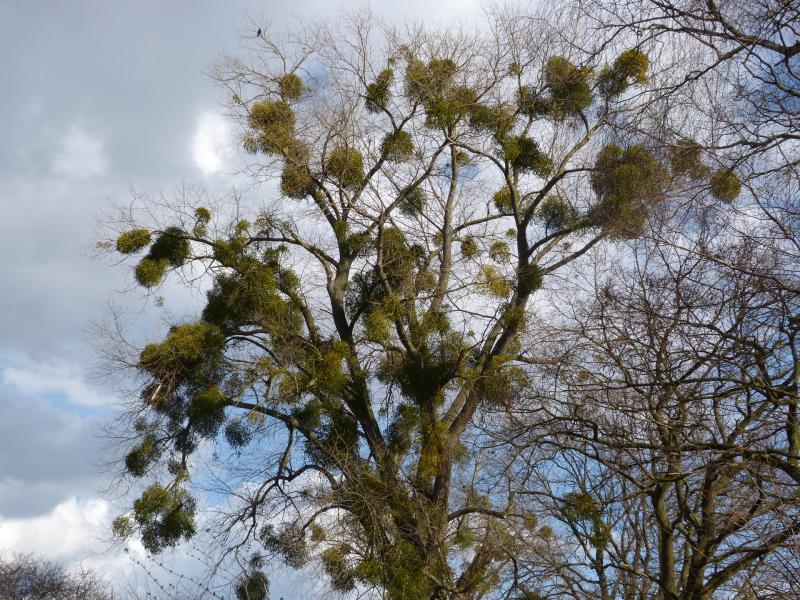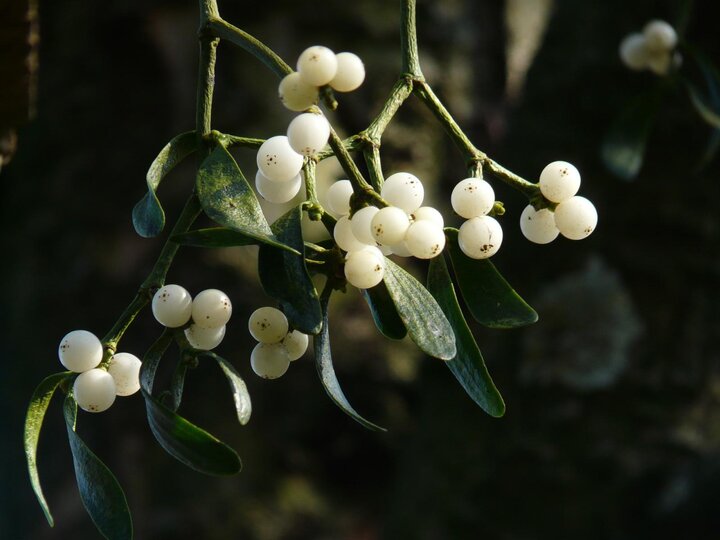Sarah Browning, Nebraska Extension Educator

Mistletoe plants are made up of many short branched stems and are easy to see in winter after the host tree drops its foliage. Image from Pixabay.com.
One plant irrevocably tied to the holiday season is mistletoe, bringing to mind the image of greenery hung over a doorway in anticipation of a kiss. The white-berried plant we decorate with during the holidays, commonly known as American mistletoe, is one of approximately 1,300 mistletoe species worldwide. All have a very interesting life history, including some good and some bad, so read on for a little background information about the plant behind our Christmas traditions.
A Little History...
Mistletoe has been part of human history for thousands of years; its association with celebrations pre-date Christians and the celebration of Christmas. The ancient Greeks used mistletoe berries to treat many medical conditions and also considered it an aphrodiasiac.
Since mistletoe has evergreen leaves, Celtic druids considered it a symbol of vitality. They believed a drink made with mistletoe could provide fertility to any animal or human and was also an antidote to all poisons. They also believed it could ward off evil spirits. Branches were hung in doorways at the start of a new year to protect the house for the next year. A mistletoe branch also invited love, peace and goodwill into the home.
In an old Norse legend, Baldur the son of Odin, god of war, was prophesied to be killed. His mother Frigg, goddess of love, met with all living things - plants and animals - getting their promise not to harm her son. But she forgot to talk with the lowly mistletoe, so Loki, the trickster, made an arrow of mistletoe wood and killed Baldur. In one version of the story, the gods were able to resurrect Baldur, so Frigg declared mistletoe a symbol of love and promised to kiss anyone who passed beneath it. This may be the beginning of our modern practice of kissing under the mistletoe.
The first mention of mistletoe in Christmas celebrations seems to be by Charles Dickens in the days of Victorian England. At that time, the tradition of hanging mistletoe for Christmas joined with the Norse tradition allowing a man to steal a kiss from any woman caught under the mistletoe. If the woman refused the kiss, it was bad luck. A berry was removed from the branch for each kiss and when all the berries were gone, the kissing had to end.
North American Mistletoe
Two species, American mistletoe and dwarf mistletoe are native to the United States, although neither type grows in Nebraska. American mistletoe is found from New Jersey to Florida and west through Texas, where it is commonly harvested and sold during the holiday season. Dwarf mistletoe, much smaller than its cousin, can be found growing from central Canada and southeastern Alaska to Honduras and Hispaniola, but most species of mistletoe are found in western United States and Mexico.

One unique characteristic all mistletoe species have in common is they are parasitic plants. In fact, American mistletoe's scientific name, Phoradendron, means "thief of the tree" in Greek. The plant is aptly named: it begins its life as a very sticky seed that must hitchhike to a new host tree on a bird beak, foot or feather, poop or on mammal fur. (In it's native range, mistletoe berries are an important food source for many bird species.)
The plant's common name - mistletoe - is derived from early observations of mistletoe appearing in places where birds had left their droppings. "Mistel" is the Anglo-Saxon word for "dung," and "tan" is the word for "Twig". Thus, mistletoe means "dung-on-a-twig."
For the most part, mistletoe is pretty haphazard about what host tree it finds - dwarf mistletoe usually grows in conifers; American mistletoe are found on an incredible variety of trees.

Eventually, mistletoe grows into thick masses of branching, misshapen stems within the canopy of the host tree, giving rise to the popular name "witches' brooms" or the apt Navajo name of "basket on high." This "basket" of twigs serves as an important nesting site for many birds and squirrels.
Mistletoe Impact on Trees
How does this thievery impact the trees mistletoe lives on? Ecologists point out that mistletoes are a native group of plants that have been around thousands, or even millions, of years, and are a natural part of forest ecological systems in the southwestern U.S.
Also, a greater variety and abundance of cavity nesting birds have been documented in mistletoe-laden trees. Although the lifespan of mistletoe-laden trees is considerably shorter than that of non-infected trees, parasitized trees can still live for several decades.
Blessing or bane? It depends on your perspective.
Images from Pixabay.com
- Mistletoe produces white berries which are an important food source for many bird species.
- The "basket" of mistletoe twigs serves as an important nesting site for many birds and squirrels.